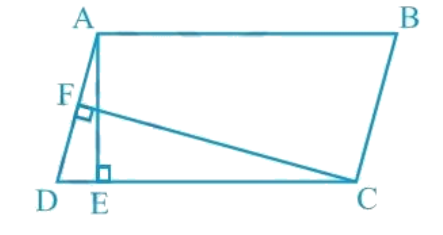In Fig. 4.94, ∠CAB=90o and AD⊥BC . If AC=75cm , AB=1m and BD=1.25m find AD . (FIGURE)
To solve the problem, we need to find the length of AD in the given triangle configuration. Here are the steps to find AD:
Step 1: Understand the given information
We have:
- ∠CAB=90∘
- AD⊥BC
- AC=75cm
- AB=1m=100cm
- BD=1.25m=125cm
Step 2: Identify the triangles
We will consider triangles △BAC and △BDA. Since ∠BAC=90∘ and AD⊥BC, we can conclude that both triangles share angle B and have right angles at A and D.
Step 3: Use the property of similar triangles
Since △BAC is similar to △BDA (by AA similarity criterion), we can set up a proportion based on their corresponding sides:
BABD=ACAD
Step 4: Substitute the known values
Substituting the known lengths into the proportion:
- BA=100cm
- BD=125cm
- AC=75cm
- AD is what we need to find.
The equation becomes:
100125=75AD
Step 5: Simplify the left side
The left side simplifies to:
100125=45
Step 6: Set up the equation
Now we have:
45=75AD
Step 7: Cross-multiply to solve for AD
Cross-multiplying gives:
4⋅AD=75⋅5
4⋅AD=375
Step 8: Solve for AD
Now divide both sides by 4:
AD=3754cm
Calculating this gives:
AD=93.75cm
Final Answer
Thus, the length of AD is 93.75cm.
---
We have:
- ∠CAB=90∘
- AD⊥BC
- AC=75cm
- AB=1m=100cm
- BD=1.25m=125cm
We will consider triangles △BAC and △BDA. Since ∠BAC=90∘ and AD⊥BC, we can conclude that both triangles share angle B and have right angles at A and D.
Since △BAC is similar to △BDA (by AA similarity criterion), we can set up a proportion based on their corresponding sides:
BABD=ACAD
Substituting the known lengths into the proportion:
- BA=100cm
- BD=125cm
- AC=75cm
- AD is what we need to find.
100125=75AD
The left side simplifies to:
100125=45
Now we have:
45=75AD
Cross-multiplying gives:
4⋅AD=75⋅5
4⋅AD=375
Now divide both sides by 4:
AD=3754cm
Calculating this gives:
AD=93.75cm
Thus, the length of AD is 93.75cm.
Topper's Solved these Questions
Similar Questions
In Fig. 4.94, ∠CAB=90o and AD⊥BC . If AC=75cm , AB=1m and BD=1.25m find AD . (FIGURE)
View SolutionIn Fig. 4.95, if ∠ADE=∠B show that ADE~ABC . If AD=3.8cm , AE=3.6cm , BE=2.1cm and BC=4.2cm , find DE . (FIGURE)
View SolutionIn Fig. 4.57, AE is the bisector of the exterior ∠CAD meeting BC produced in E . If AB=10cm , AC=6cm and BC=12cm , find CE . (FIGURE)
View SolutionIn a ABC , AD is the bisector of ∠A , meeting side BC at D . If AD=5.6cm , BC=6cm and BD=3.2cm , find AC . (ii) If AB=10cm , AC=6cm and BC=12cm , find BD and DC .
View SolutionIn Fig. 10.57, a circle is inscribed in a quadrilateral ABCD in which ∠B=90o . If AD=23cm , AB=29cm and DS=5cm , find the radius r of the circle. (FIGURE)
View SolutionIn Fig.20, ABCD is a parallelogram, DL⊥AB and DM⊥BC. If AB=18 cm , BC=12 cm and DM=9.3 cm, find DL.
View SolutionIn a ABC , AD is the bisector of ∠A , meeting side BC at D . If AB=10cm , AC=14cm and BC=6cm , find BD and DC (ii) If AC=4.2cm , DC=6cm and BC=10cm , find AB . (iii) If AB=5.6cm , AC=6cm and DC=3cm , find BC .
View SolutionIn a ABC , AD is the bisector of ∠A , meeting side BC at D . If BD=2.5cm, AB=5cm and AC=4.2cm , find DC . (ii) If BD=2cm, AB=5cm and DC=3cm, find AC . (iii) If AB=3.5cm , AC=4.2cm and DC=2.8cm , find BD .
View SolutionIn Figure, ABCD is a parallelogram, AE ⊥DC and CF⊥AD . If AB=16CM, AE=8cm and CF=10cm, find AD

View SolutionIn a ABC , D and E are points on the sides AB and AC respectively such that DEBC If AD=4 , AE=8 , DB=x−4 , and EC=3x−19 , find x (ii) If AD=8 cm , AB=12cm and AE=12 cm , find CE . (iii) If AD=4 cm , DB=4.5 cm and AE=8 cm , find AC .
View Solution
